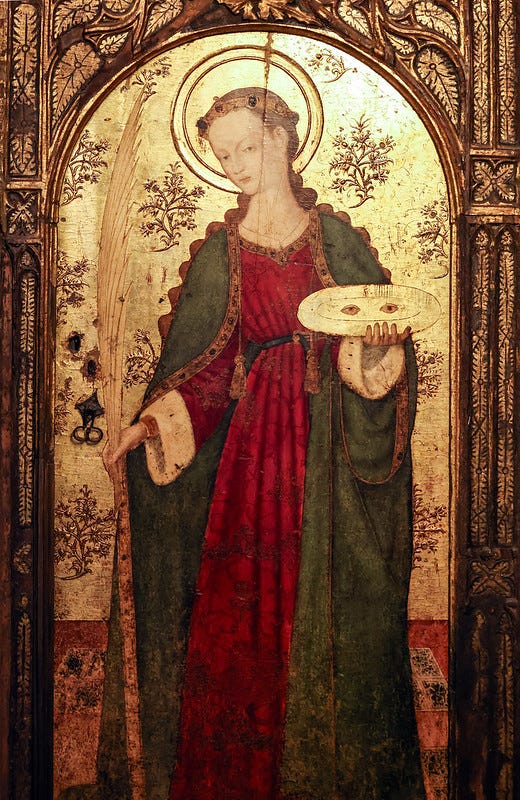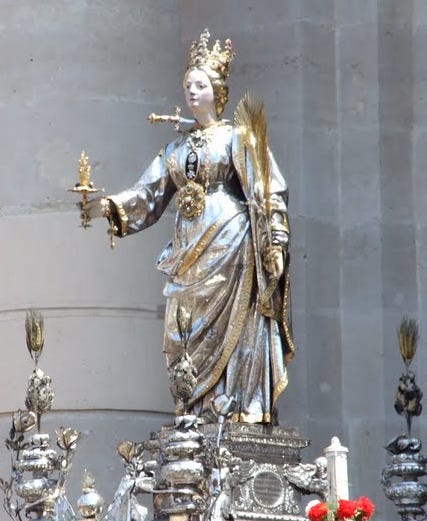
If you happened to be in Sweden today, December 13, you might spot a young girl in white with an evergreen wreath on her head accented with lighted candles, carrying a platter of goodies. If you asked what was going on, you may not get a satisfying answer, but that’s only because you don’t speak Swedish, now do you?1 If you did get an answer in English, you’d learn that it was Saint Lucia’s Day, or Saint Lucy as she is known in the English-speaking world.
who was Lucy?
All we really know for sure about Lucy is that she was martyred in Syracuse, Sicily in or around the year 304. Her death came during the persecutions of the emperor Diocletian, the same persecutions that likely saw Nicholas of Myra in prison hundreds of miles away.
Tradition, though, provides a bit more of a story. The daughter of a wealthy family in Syracuse, Lucy made a vow to devote her life to Christ and remain a virgin, and she hoped to give her dowry to the poor.
However, her ill mother arranged her marriage to a pagan nobleman. Knowing that she couldn’t convince her mother to let her honor her vow, she prayed at the nearby tomb of Saint Agatha. Agatha appeared to her in a dream and told her that her mother would be healed of her illness.
The healing came to pass, of course (it would hardly be a good story if it didn’t), and Lucy was able to convince her mother to let her honor her vow.
Her pagan would-be suitor, on the other hand, was not so happy. He snitched about her faith to the governor, who ordered that she be sent to a brothel to be forced into prostitution.
But when the soldiers came to take her away, they found that they couldn’t move her, as hard as they may try. In one version of the story, they even tie a yoke of oxen to her, but she doesn’t budge. So, they pile wood around her, but the wood won’t catch fire. Finally, a soldier thrusts his sword into her neck, and she is martyred for Christ.
Because her name means light, Lucy eventually became the patron saint of the blind. It is probably because of this (and not the other way around) that an additional element of her story came to be: that her eyes were gouged out. In one version, the pagan governor has them torn out as a part of her torture. In another, she rips them out herself to discourage the suitor who was infatuated with them. Either way, the story continues that after her death, her eyes were miraculously restored to their sockets.
Because of this story, Lucy is often depicted holding her eyes on a platter. Yeah, it doesn’t make much sense to me, either.
what can we learn from Lucy?
We may not know for sure if her story is true, but there is still a lot that we can learn from her.
We at least know that she died for her faith. Matthew 5:10 says “Blessed are those who are persecuted for righteousness' sake, for theirs is the kingdom of heaven.”2 And in Romans 8:35, Paul writes “Who shall separate us from the love of Christ? Shall tribulation, or distress, or persecution, or famine, or nakedness, or danger, or sword?”3
Lucy’s story shows her standing firm in her belief in Christ. All the powers of earth cannot move her. Paul says “Therefore take up the whole armor of God, that you may be able to withstand in the evil day, and having done all, to stand firm.”4
Today, we pray that the Holy Spirit will help us to stand firm in the face of any challenge to our faith, great or small.
Sources
Tai French, “Saint Lucy’s Day: A Rookie Anglican Guide,” Anglican Compass, https://anglicancompass.com/saint-lucys-day-a-rookie-anglican-guide/.
“St. Lucy,” Brittanica, https://www.britannica.com/biography/Saint-Lucy.
“St. Lucy,” Catholic Online, https://www.catholic.org/saints/saint.php?saint_id=75.






your image caption was the real kicker in this piece . . .
Thanks for sharing about St. Lucia. I've heard of the feast but had no idea she was a martyr.